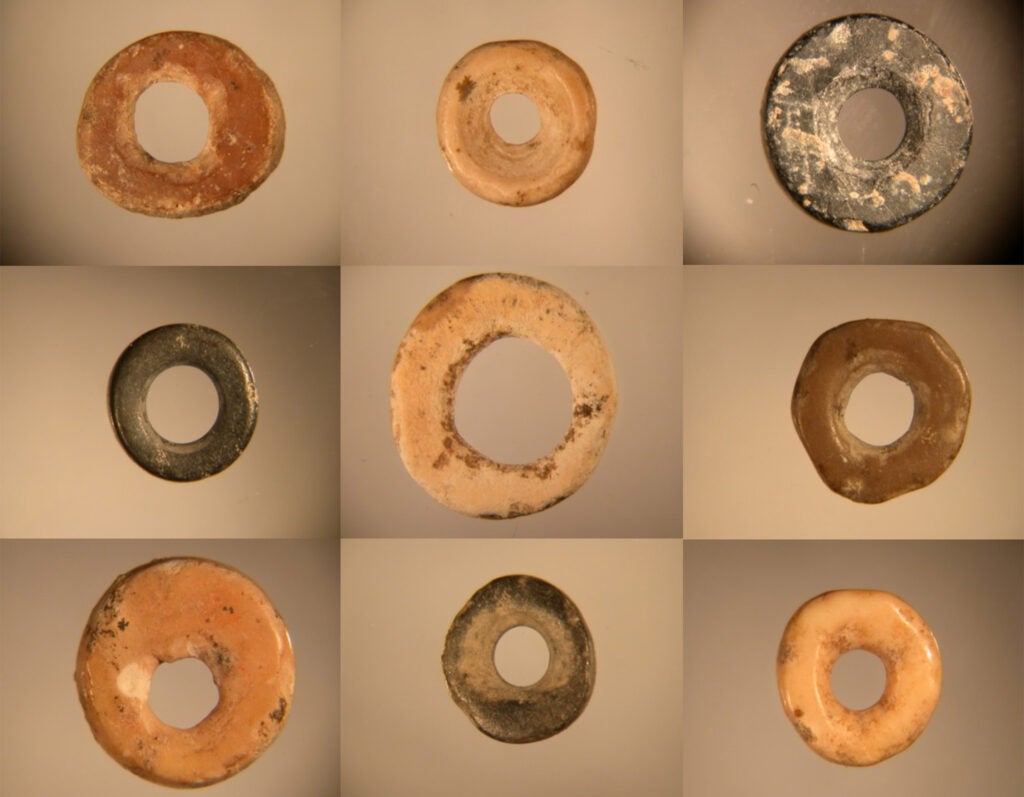Between 80,000 and 50,000 years ago, people across early eastern and southern Africa left behind traces of an explosion of symbolic expression reflected in far more intensive use of eggshell beads, pendants, pigments, and other art.
Archaeologists have long hypothesized that these new creations were likely the result of major changes in where and how people lived, traveled, and interacted, but the theory has been difficult to test and prove. The problem is the items alone don’t tell the full story. To get at that missing piece of the puzzle, a team of archaeologists and geneticists turned to the ancient people themselves.
A new study analyzing ancient human remains has produced the earliest DNA from sub-Saharan Africa and gives a more complete look at how people from different regions moved around the continent, a shift that led to the creation of social networks for trade and information-sharing. The analysis also shines fresh light on the ancestral populations of almost all foraging peoples in eastern and southern Africa, including ancient and modern hunter-gatherer populations.
A team of 44 researchers, co-led by Harvard geneticists David Reich and Mark Lipson and archaeologist Mary Prendergast, A.M. ’05, Ph.D. ’08, an associate professor at Rice University and a 2016-17 Radcliffe Fellow, describe the findings in Nature. The study is the latest in a series of papers that find their roots in the time Prendergast spent at Radcliffe and met Reich, ultimately leading to their collaboration in using ancient DNA to shed light on questions in African archaeology.
“All humans today descend from ancestors who lived in Africa more than 100,000 years ago, and Africa today is the place on Earth where our species is most diverse,” said Reich, a professor in the Department of Human Evolutionary Biology and a professor of genetics at Harvard Medical School. “But while we all recognize the centrality of Africa, we often overlook Africa in the last 50,000 years.”
The new study helps fill this gap through the analysis of DNA data from six ancient individuals found in areas now part of Malawi, Tanzania, and Zambia. Three date from 14,000 to 20,000 years ago, more than twice as old as the oldest ancient human DNA formerly studied from the region. In addition, the genetic material is the first such data examined from the Late Pleistocene age (the geological period from about 130,000 to 12,000 years ago).
The researchers looked at these data alongside that from 28 individuals buried at sites across the continent to gain new insight into the genetic population structure of eastern and southern Africa.
The analysis shows that most foragers in eastern and southern Africa derived substantial ancestry from three source populations instead of two, as previously thought. The third came from central Africa and became mixed with eastern and southern groups.
“What we’re seeing is a three-way mixture of deeply divergent modern human lineages,” Reich said. “The central contribution of people related to today’s central African rainforest hunter-gatherers was not previously appreciated.”


Ostrich eggshell beads from Tanzania were found where one of six ancient individuals being studied was buried. Harvard's David Reich (pictured) co-led the study that gives a more complete look at how people from different regions moved around the continent, a shift that led to the creation of social networks for trade and information-sharing.
Photos by Jennifer Miller; Jon Chase/Harvard Staff Photographer
The analysis showed these groups moved thousands of kilometers across Africa between 20,000 and 50,000 years ago and mixed in different proportions.
“Over millennial timescales, migration brought together people whose ancestors had lived in distant parts of Africa and had been largely separated for 200,000 years,” said Prendergast. “This produced a cline of ancestry, with roots in eastern, southern, and central Africa.”
The work also showed that by about 20,000 years ago — roughly the date of the oldest samples analyzed— the ancestry mixes of many forager populations were changing relatively little.
“People had stopped moving around as much — they lived locally,” Prendergast said.
The researchers noted, however, that materials for art and tools were still frequently on the move, signifying a strong trading network. Artifacts began to differ stylistically from one region to the next, perhaps reflecting local ideas about aesthetics.
“Archaeology shows us that by 20,000 years ago, social networks were pretty well developed, and that enabled people to live and interact with people extremely locally while still taking part in wide-ranging cultural exchanges,” Prendergast said.
Researchers say the paper serves as a prime example of how geneticists and archaeologists can work together to open windows into the lives of ancient peoples. This is the third original research paper from the collaboration on ancient DNA in Africa sparked by Prendergast’s year at Radcliffe.
Along with Prendergast, Reich, and members of his lab, the research team included scholars from Canada, Kenya, Malawi, Tanzania, Zambia, and other countries. The project is part of a general push in the field of genetics to diversify what DNA is studied, especially in Africa.
“Only about 3 percent of ancient DNA data has come from the continent of Africa,” Reich said. “That’s an extraordinary imbalance when it comes to learning about some of the most important, complex, and difficult-to-understand moments in our species’ past.”

Post a Comment